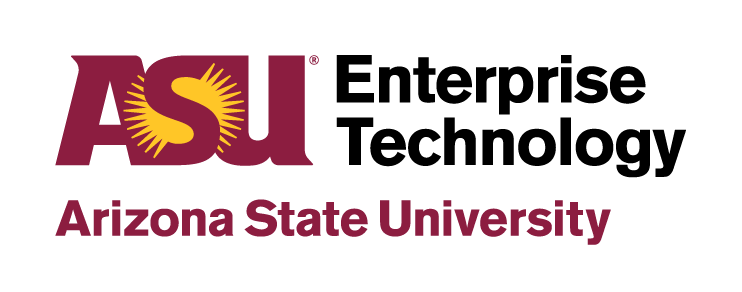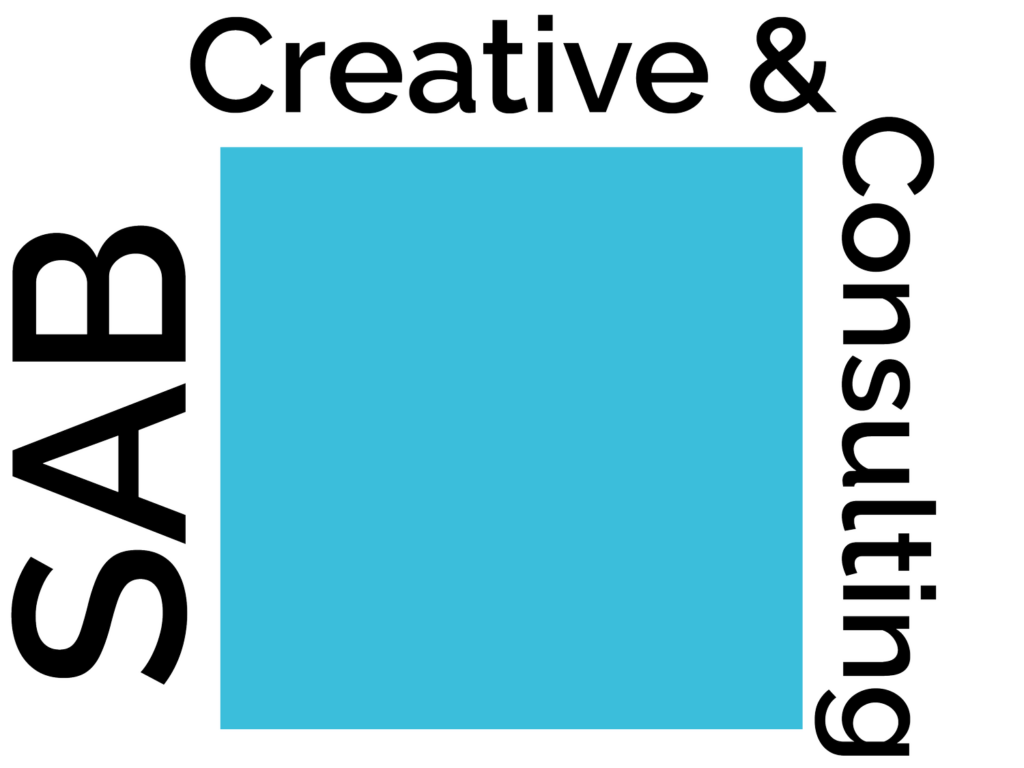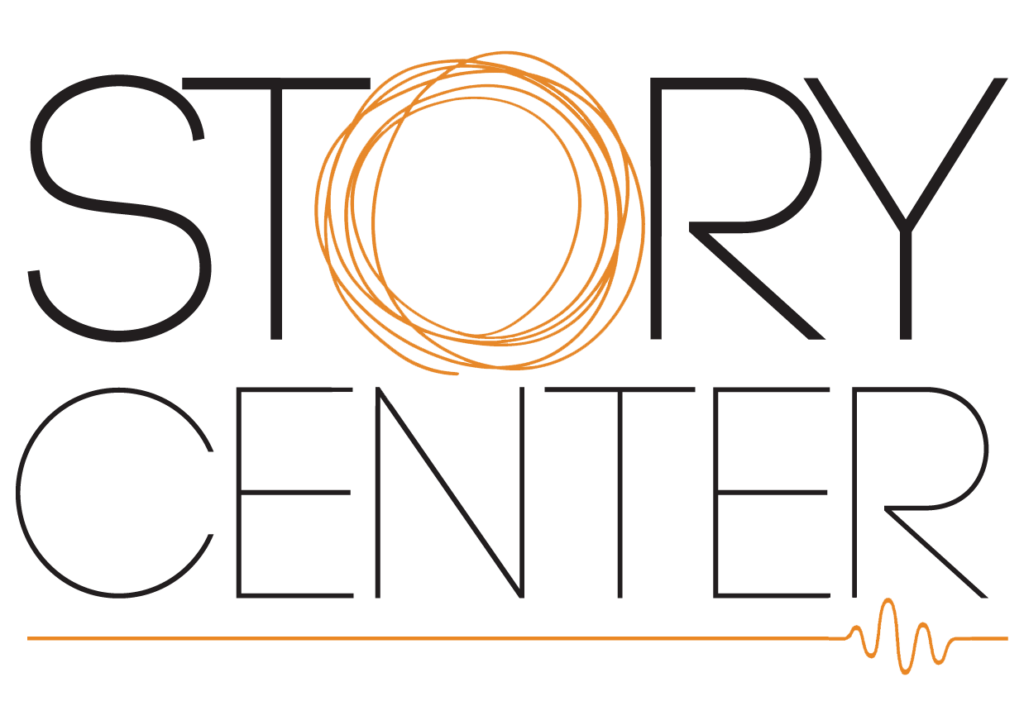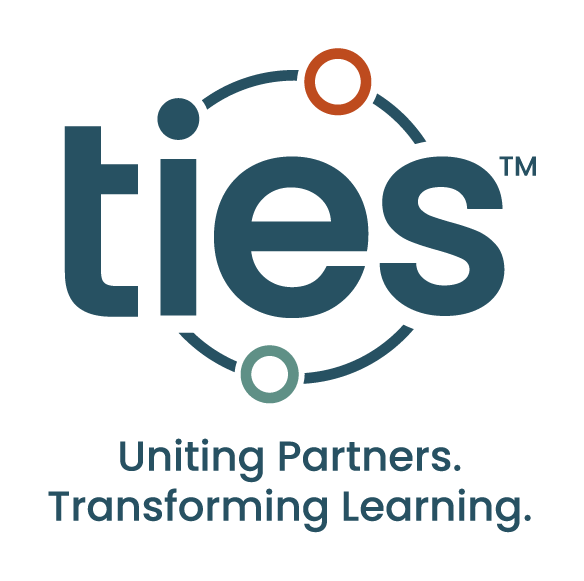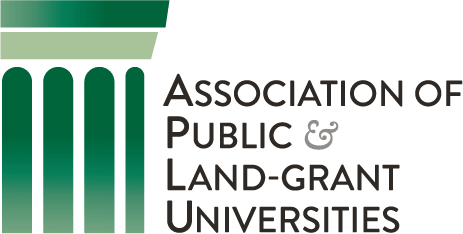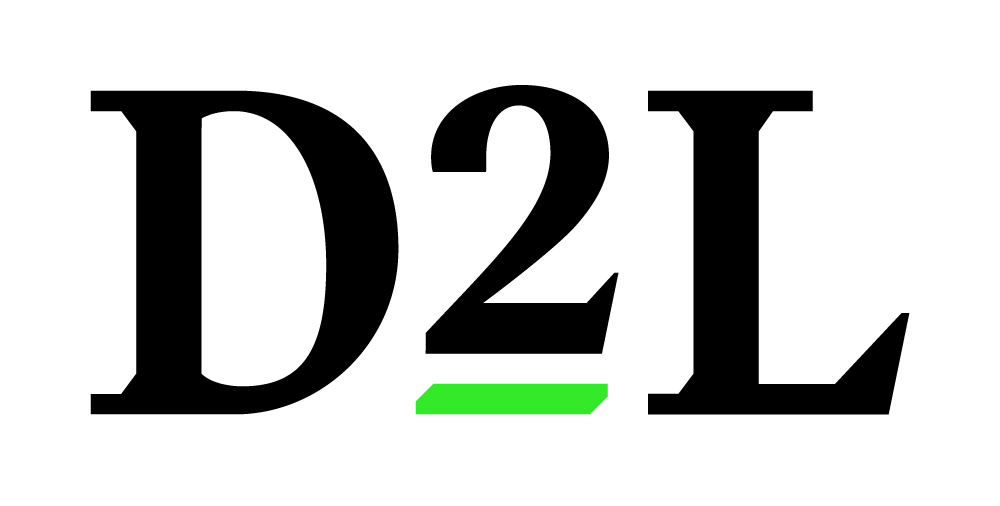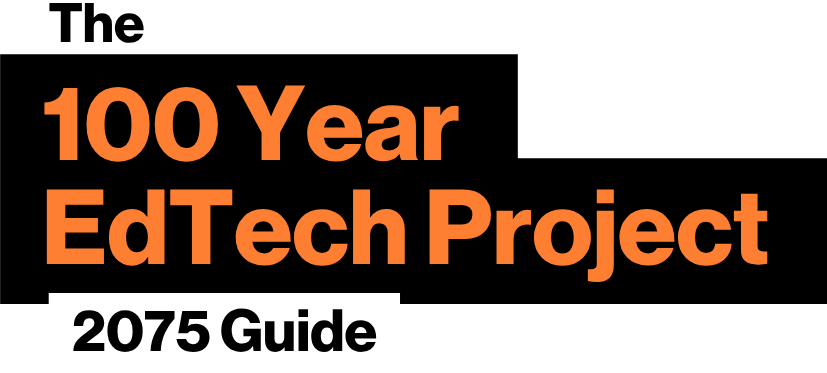
Education and technology changemakers across the globe strategically plan for the next 50 years.
The 100 Year EdTech Project sees education and technology as essential partners in building a thriving future.
We look 50 years back and 50 years ahead—letting the past inform what comes next.
Our mission is to spark collaboration across diverse voices to imagine and shape bold, inclusive approaches to learning for the century ahead.
Photos by Mike Sanchez
Inside the Publication
Contents
I. Opening Letter
A Future We All Helped Write
II. How to Use This Guide
Putting long-term thinking into practice
III. The Timeline
From 1964 to 2075: Key milestones in education and technology
IV. Executive Summary
The Prompt, the People, and the Process
V. Common Threads
Signals and patterns across the 12 futures
VI. Scenario Visions
Twelve speculative futures from the 2025 Design Summit
VII. The Living Framework
Design principles revisited and interpreted
VIII. Final Word: Calls to Action
Seven actionable priorities for the next era
IX. Afterword
Carrying the 10–25–50 framework forward
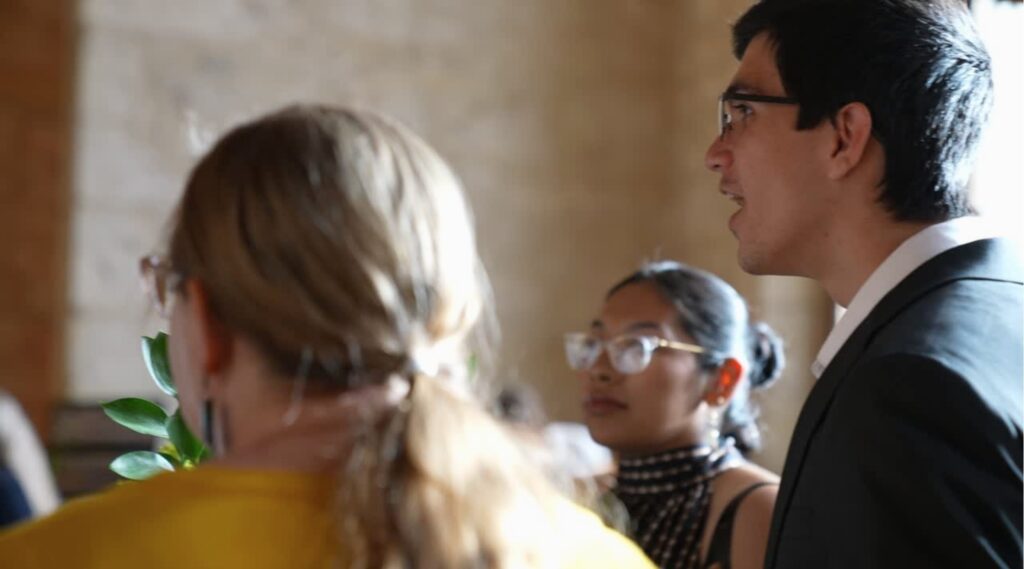
Executive Summary
The Prompt, the People, the Process
What could the world look like in 2075 — and what role must education and technology play in bringing it into being?
This was the central prompt behind the 2025 Design Summit, held in San Antonio, Texas. Over two days, 174 participants from 71 organizations came together to imagine the next 50 years of learning.
Students, educators, technologists, artists, researchers, and policymakers worked across generations and sectors, guided by a future-oriented framework: 10–25–50. This approach asked them to explore what might be built in the next 10 years, transformed in 25, and sustained as legacy in 50.
Twelve speculative future scenarios served as the springboard for that work. Each was paired with a short film and explored through facilitated design sprints. The ideas that emerged ranged from AI-powered learning tools and decentralized trust networks to mobile libraries for climate migrants and curiosity-centered assessments.
While each future told its own story, a set of patterns began to surface across them. These seven Common Threads reflect the structural shifts participants named as critical to the decades ahead, pictured on the next page.
From these shared priorities, a series of Calls to Action emerged. Each is drawn directly from participant-generated solutions and reflects the practical, immediate steps that institutions and communities can begin to test, fund, or scale.
These include:
- Advancing AI literacies and information ethics through policy, training, and public engagement
- Designing emotionally intelligent, human-centered AI tools that support learning without replacing educators
- Launching learner-owned, modular credentialing systems that are portable across geographies and institutions
- Making mental and emotional wellbeing a design standard for learning environments and education policy
- Building new models of legitimacy and governance rooted in community trust and cross-sector collaboration
- Retrofitting libraries as mobile, climate-adaptive learning hubs for displaced learners and knowledge exchange
- Embedding curiosity into assessments, funding strategies, and organizational decision-making
This guide is more than a retrospective. It’s an invitation to experiment, to collaborate, and to plan beyond the immediate.
Whether you work in a classroom, district office, nonprofit, foundation, edtech company, or public agency, this is your call to design with the long term in mind—and with others at the table.
The future isn’t something we await. It’s something we build together.
We All Helped Write
Dear fellow stewards of possibility,
It is the year 2075. We are now a full century into the grand experiment once known as “educational technology.” What began as a pursuit of tools has evolved into an infrastructure for global, and increasingly interplanetary, co-learning and human flourishing.
More than any single institution, it was a 1968 demonstration by Doug Engelbart that set this transformation in motion. Engelbart didn’t just showcase early tools; he offered a framework for augmenting human intellect and solving complex challenges together. His vision of Networked Improvement Communities became the foundation for the socio-technical ecosystems we rely on today: civic, adaptive, and anchored in shared learning.
By the mid-21st century, the limits of traditional educational structures were clear. Our systems evolved. Learning moved beyond walls and timelines—into learning circles, design studios, and AI-facilitated pathways rooted in community, identity, and care. Learners no longer “graduate.” They contribute, pause, retool, and re-emerge. Belonging replaced access as the key measure of success.
AI has since become more than a tool. It is a conscience, collaborator, and catalyst. Its architectures — open, co-governed, and informed by Indigenous, neurodiverse, and global South epistemologies — are what make trust possible. Learning is now immersive and somatic. Memory palaces meet quantum sandboxes. Story meets system.
We’ve reframed education as civic infrastructure. Like clean water, it is essential, everywhere, and co-stewarded. Our compass has shifted from dominance to dialogue. We no longer ask “What do you know?” but “What can we become together?”
As we mark this centennial moment, I am grateful for those in 2025 who imagined boldly and acted collectively. The learning futures we now inhabit were not born from certainty—but from shared invention across generations, disciplines, cultures, and systems.
The future is not inevitable. But it is imaginable. And it remains ours to build — together.
With enduring solidarity and open curiosity,

Lev S. Gonick
Educator, Systems Thinker, Learning Futurist
Phoenix-Lunar Corridor, Earth & Beyond
June 2075
To the architects of what’s possible,
Curiosity has always been a fragile force—powerful, yet easily suppressed. A few months before the 2025 Design Summit, I co-authored The Death of Curiosity, a scenario that asked what might happen if our systems, by design or neglect, extinguished the instinct to question. Alongside it, Teaching in a Post-Truth World explored a related breakdown in how truth is shaped and shared.
At the Summit, these futures became ground for collective response: what could still be built, and how?
Within a decade, the media landscape fractured. Social platforms were overtaken by synthetic content; official sources by corporate or state control. Education systems were hollowed out. Curricula disappeared. In many places, formal learning structures collapsed.
In that void, community became the only reliable source of knowledge. Art returned as a vehicle for truth. People taught and learned through shared experience—music, food, storytelling. Libraries moved offline. Notebooks replaced screens.
Over time, artificial intelligence evolved. What began as disorientation became discernment. Personal “truth agents,” once a speculative design, became essential—verifying claims, assessing risk, and supporting ethical judgment.
The decades that followed brought reinvention. Education became localized, intergenerational, and deeply human. Digital environments prioritized trust and belonging over scale. Lifelong learning became not just language, but infrastructure.
And yes, we reached Mars. Whether we’re ready to talk about what we found is another story.
What I want you, dear readers, to remember is that the scenarios we addressed were not merely predictions. They were vital provocations. What matters most is not whether they came true, but how they helped us navigate what did.
In solidarity with all who continue to imagine and construct,
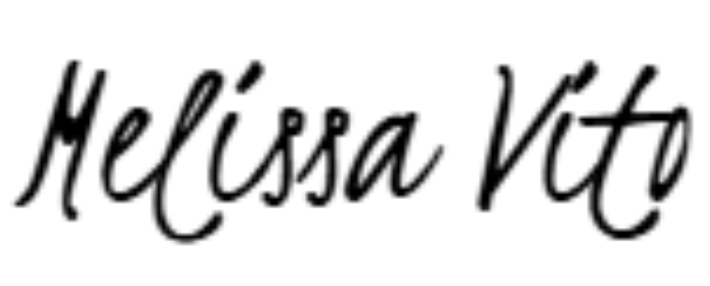
Melissa Vito
Strategic Advisor, Digital Learning Architect, Higher Education Leader
Southwest Knowledge Corridor, Earth and Extended Networks
June 2075
How to Use This Guide
The 2075 Guide was created to support strategic planning that extends beyond immediate demands. It helps you make choices that endure — across decades, generations, and systems. Whether you’re facilitating a retreat, leading a class, hosting a design session, or working solo, the guide can ground new ideas, test existing ones, and align people around a shared vision. Here are concrete ways to use it, and the challenges it’s built to help you navigate:
This is not a static report. It’s a living tool for reflection, design, and action. Revisit it. Remix it. Use it to lead conversations that matter — and shape the story ahead.
1
Deeper Strategic Planning
Use the guide to expand your planning scope. Develop 10-, 25-, or even 50-year strategies that root near-term actions in long-term vision.
Solves for: short-term thinking, disconnected goals, and reactive decision-making
2
Program and Policy Design
Translate scenario insights into new policies, learning models, credentials, or technology pilots. Use the Calls to Action and Common Threads to anchor design.
Solves for: outdated models, siloed efforts, and solutions that don’t scale
3
Auditing and Aligning Existing Work
Compare your current initiatives to the vision laid out here. Identify what’s aligned, what’s missing, and what needs to evolve.
Solves for: legacy systems, scattershot priorities, and unclear alignment with future needs
4
Facilitating Strategic Conversations
Use the scenarios or design principles to structure workshops, team discussions, or stakeholder engagements. Create shared language across roles and institutions.
Solves for: siloed planning, misaligned initiatives, and disengaged stakeholders
5
Storytelling and Advocacy
Incorporate the guide’s insights into messaging for funders, policymakers, boards, or the public. Use it to shape narratives that center imagination and agency.
Solves for: uninspired messaging, fear-based appeals, and communication gaps
6
Building Futures Literacies
Make this guide part of an ongoing learning culture. Use it to practice long-term thinking and build speculative capacity.
Solves for: reactive planning cycles, limited foresight, and low comfort with uncertainty
The Past 50 Years of Education and Technology: At a Glance
1964 - 73
1968: Engelbart’s Mother of All Demos
1969: Arpanet Open University
1971: Personal Computers and Instant Messaging
1972: Email
1974 - 83
1974: Cerf and Kahn: A Protocol for the Internet
1974: Ted Nelson: Computer Lib/Dream Machines
1982: First instance of “online learning”
1984 - 93
1987: First mobile phone
1989: First fully online degree program (University of Phoenix)
1992: First “smart phone” (IBM)
1993: First web browser (Mosaic)
1994 - 2003
1994: School internet
1995: First commercial VR headset, Privacy-enhancing tech
1996: First accredited, web-based university
1998: First LMS
2000: The intro of Open Educational Resources
2004 - 13
2009: BYOD
2010: Flipped classroom + MOOCs + learning analytics
2011: Gamification and digital badges
2012: Personalized Learning Environments
2013: Pilots with adaptive learning technologies
2014 - 25
2014: Blockchain and crypto
2015: Launch of Open AI
2018: Chatbots and virtual assistants proliferate
2020: Remote learning; virtual labs/simulations
2023-25: Generative AI mass integration into learning and work
2025—2075:
It’s up to us.
The Next 50 Years of Education and Technology: At a Glance
2026-35
Laying the Foundation
2026: Internet and AI literacies declared a universal human right; first national policy adopted
2027: Launch of public “Knowledge Trusts” issuing Universal Learning Credits
2028: First AI emotional learning assistant deployed in K–12 education
2029: U.S. adopts formal sabbatical policy for public educators and mid-career learners
2030: Global coalition launches GRACE (Governance, Research, Academia, Companies, Ethics) to guide AI oversight
2031: First universal “Educational Passport” pilot launched in five countries
2033: Curiosity designated as a core competency in federal education assessment frameworks
2034: Regional library retrofits begin—climate-adaptive and mobility-equipped learning hubs
2035: Nexus prototype deployed—an open-source, quantum-powered learning interface
2036-50
Systems in Transition
2036: First global accreditation network replaces degree-based recognition with skill stacks
2038: Emotional intelligence certification becomes required for teacher preparation programs
2040: AI-human collaborative policy forums become standard practice in public education design
2042: Modular “Declaration Day” frameworks adopted by major university systems worldwide
2043: Neural literacy included in global UNESCO learning competencies
2044: 3D printing consortia form to co-govern housing, health, and educational tools
2045: Digital curiosity portfolios replace GPA in 50% of U.S. high schools
2046: AI regulation standards embedded into all LMS and EdTech platforms
2048: The first fully portable, blockchain-verified educational pathway spans five continents
2050: Mental health infrastructure becomes a baseline requirement for all accredited learning systems
2051-7
Transformation realized
2051: National borders decouple from educational jurisdictions; regional networks hold authority
2053: Libraries become the largest public investment in learning infrastructure since public schooling
2055: All government AI tools required to follow open-source ethical protocols
2057: First generational impact study links curiosity-centric learning to reduced societal polarization
2060: Earth’s largest “Nomadic University” launches for climate-displaced learners
2062: AI conscience councils required in all education policy bodies
2065: First interplanetary learning cohort co-enrolls students from Earth and Mars orbit research colonies
2068: The concept of “graduation” is retired across all global education systems
2070: The Global Learning Mesh becomes the dominant infrastructure for civic, cultural, and ecological collaboration
2075: Centennial of educational technology marked by Declaration of Learning as Civic Infrastructure, globally ratified
Common Threads: Signals and Patterns Across the Futures
While each future told its own story, certain truths kept echoing — quiet at first, then loud enough to shape the world to come.
Truth and Trust in the Age of AI
Scenarios like Teaching in a Post-Truth World, The Knowledge Nexus, and The Ethical Firewall emphasized the urgency of reestablishing trust across media, governance, and education systems. Participants imagined encrypted knowledge caches, decentralized AI co-governance structures, and educational tools that foster discernment over rote knowledge. Trust, in these futures, is not inherited. It is intentionally built and continuously tested.
Learning as Continuous, Mobile, and Mission-Driven
In Declaration Day, The Neverending Classroom, and Beyond Borders, education is not bound to a degree, age, or geography. Learners hold passport-style records, declare personal grand challenges, and move fluidly across ecosystems. Success is measured not by credentials earned, but by contributions made. Education becomes a continuous, portable journey centered on solving real problems.
Wellbeing as Infrastructure
Mental health, emotional intelligence, and neural ethics appeared not only in Health and Mental Wellbeing and The Unencumbered Brain, but throughout. Participants envisioned AI-powered emotional tools, global ethics frameworks, and schools as centers of collective care. Wellbeing isn’t an outcome. It’s the foundation on which future systems are built.
Technology That Extends Humanity
Rather than treating AI, robotics, or neural tech as inevitable replacements for human labor or thinking, scenarios like Replicators Rising, The Positive Impact of AI, and The Knowledge Nexus framed technology as a design partner. Teams proposed human-machine collaboration models that amplify creativity, adapt to emotion, and honor neurodiversity. Still, concerns about surveillance, bias, and loss of agency drove calls for rigorous oversight and inclusive governance.
Decentralized Systems, Distributed Power
In futures like Beyond Borders and The Knowledge Nexus, participants worked to decentralize authority and redefine legitimacy. Education no longer flows from national standards or elite institutions. Instead, it emerges from regional compacts, peer-to-peer credentialing, and cross-institutional networks. Legitimacy is earned through community trust and usefulness, not compliance.
Climate Response and Planetary Citizenship
Scenarios such as Climate Caravan and EcoGenesis centered education as a frontline response to environmental disruption. Whether through pop-up libraries, nomadic learning systems, or planetary stewardship curricula, the focus was on adaptive infrastructures that support displaced communities and ecological repair. Learning becomes a survival tool and a means of honoring interdependence.
Curiosity as a Civic Value
The Compliance Protocol warned of what happens when learning systems prioritize control over curiosity. This thread showed up across other scenarios too, as a resistance to optimization, standardization, or metrics-driven models. Several groups asked how we design for inquiry, not just outcomes. Curiosity must be protected by policy, practice, and culture, because without it, nothing else evolves.
Scenario Visions: 12 Futures of 2075
Each of the twelve scenarios in this section began with the same question, taken in wildly different directions. These are not predictions. They are provocations.
Scenario 1: Teaching In a Post Truth World
In a fractured information landscape, truth has become both elusive and essential. While technologies exist to verify facts, they’re often deployed by regimes more interested in using them to control the narrative. Official channels are not always trustworthy. In response, underground “truth caches,” encrypted libraries, and critical thinking tools — like an AI wrist assistant to prompt critical questions — help learners navigate competing realities. Education in 2075 is no longer about information transfer, but developing high levels of discernment. Those who flourish are informed, curious, skeptical, and equipped to balance between official narratives and decentralized, trusted knowledge webs.
Design Session Highlights: Key Ideas and Creative Tensions
- Grappled with the tension between relying on flawed human judgment vs. surrendering critical thinking to machines
- Imagined decentralized “truth banks” and underground knowledge networks as trustworthy alternatives to official narratives
- Proposed curiosity-prompting AI assistants to help learners question information in real time
- Recognized the limits of current problem-solving frameworks when projecting future possibilities
- Highlighted the need to teach discernment as a core survival skill
Recommended Solutions
Policy
Declare internet and AI literacy a human right, with government safeguards ensuring universal access and digital agency.
Innovation
Design decentralized “truth filters,” wearables, and learning tools that question rather than answer — prompting learners to think critically.
Resource Needs
Establish an encrypted, private global network where truths could be safely shared to preserve reliable information across generations.
Social Capital
Foster networks of trust among learners and underground educators who develop decentralized hubs for idea creation and distribution.
Scenario 2: Declaration Day - The ‘Major’ Reset
Overview
In the world of 2075, education is no longer a rigid sequence of degrees and credentials. Instead, learners declare their purpose—not just a major—at key moments in their lives. These “Declaration Days” mark a shift from subject-centered education to challenge-centered learning, where interdisciplinary teams form around real-world issues. Powered by AI mentors and global knowledge hubs, students chart personalized, purpose-driven learning paths. Curriculum is co-created, shaped by societal needs, and rooted in ethical, community-based action. This future calls for dismantling the silos of traditional disciplines and replacing them with fluid, dynamic systems that encourage creativity, impact, and lifelong evolution.
Design Session Highlights: Key Ideas and Creative Tensions
- Reimagined majors as flexible declarations tied to real-world grand challenges
- Debated how to ensure readiness and trust in more fluid, interdisciplinary pathways
- Called for collective learning models and decentralized, peer-validated systems
- Explored curriculum grounded in embodied learning, mentorship, and creativity
- Tackled how to scale systems change—from early education through higher ed and beyond
Recommended Solutions
Policy
Fund public Knowledge Trusts to issue Universal Learning Credits and remove financial gatekeeping.
Innovation
Replace majors with portable “skill stacks” verified by communities, mentors, and AI partners.
Resource Needs
Circular learning economies reward contributions with Knowledge Energy Credits instead of tuition.
Social Capital
Local knowledge councils and pluralist ethics networks determine what counts and who leads.
Scenario 3: The Positive Impact of AI on Education
Overview
In this future, AI doesn’t replace the educator — it uplifts the learner. Freed from administrative burdens, educators design more human-centered, emotionally resonant learning experiences. Students explore adaptive, personalized pathways that stretch their imagination and deepen self-awareness. AI becomes an ally in amplifying human strengths like creativity, curiosity, and social connection. But this future required the dismantling of existing power structures, the democratization of AI access, and a cultural shift that recognized families and communities as co-creators in education. Here, the best of AI isn’t measured by automation, but by how much more deeply we can think, feel, and connect.
“We really envisioned this incredible learning space where all the very best of AI was making us better as humans.” — Christa, facilitator
Design Session Highlights: Key Ideas and Creative Tensions
- Explored how AI could support, rather than replace, human creativity and learning
- Reframed the session around decertification and the dismantling of rigid systems
- Used a playful design prompt to imagine future tools based on emotion and impact (e.g., “a vacuum that makes you feel like a champion”)
- Identified the cultural and systemic barriers to using AI to its full human-centered potential
- Reaffirmed the role of community and intentional design in building a more hopeful AI-powered future
Recommended Solutions
Policy
Advance legislation that promotes the democratization of AI and policy co-creation with families and communities.
Innovation
AI-powered learning tools that adapt to students’ needs while supporting, instead of replacing, human strengths such as creativity and critical thinking.
Resource Needs
Community-based learning hubs that provide AI training, device access, and cultural integration support for learners and families.
Social Capital
Build coalitions between families, educators, and political allies to advocate for ethical AI use and the dismantling of outdated systems.
Scenario 4: The Neverending Classroom
Overview
The Neverending Classroom carries two stark interpretations. On one hand, it offers a future where learning never stops—where individuals are free to grow, re-skill, and adapt throughout their lives. On the other, it warns of a world where nonstop upskilling becomes exhausting and compulsory. Grounded in this tension, the group imagined a future where learning is inclusive and dignified. At the center is an “educational passport,” a lifelong, learner-owned record of experiences, skills, and goals. This passport would be powered by AI and recognized globally, with the goal of supporting self-authorship for learners of all walks of life.
The group grounded the conversation in the imagined life of Henry, son of the scenario’s author, Tracey Birdwell. Referencing his journey reminded everyone that this is human, personal, and real.
Design Session Highlights: Key Ideas and Creative Tensions
- Navigated the tension between the idea of growthful lifelong learning and exhausting reskilling demands
- Anchored the conversation in the idea of a learner-owned “educational passport” for skill tracking and recognition
- Proposed the normalization of learning sabbaticals to support reflection and growth
- Emphasized fairness in credentialing, regardless of formal education background
- Raised concerns about data ownership, access, and credential portability in a mobile world
Recommended Solutions
Policy
Establish privacy-protected, universally recognized credentialing systems and normalize learning sabbaticals across industries.
Innovation
AI-powered skill maps and blockchain-backed passports track, advise, and verify lifelong learning across formal and informal spaces.
Resource Needs
Public-private investment in open access to upskilling programs, immersive learning, and employer-backed education benefits.
Social Capital
Normalize career pivots, mentorship, and peer support networks as essential components of growth, rather than signs of failure or instability.
Scenario 5: Climate Caravan + Scenario 9: EcoGenesis
Overview
As climate crises intensify, borders fade and mobility becomes a fact of life. In this future, people migrate not for opportunity, but for survival and safety. Amid shifting terrains and cultural fragmentation, libraries evolve into the connective tissue of a nomadic world, serving as welcoming and adaptable places where people share resources, obtain critical information, and find community. In a time of migration, they could take portable or concrete forms, such as pop-up structures, virtual nodes, or anchored community spaces. A benevolent AI helps navigate flows of information, and a universal symbol identifiably marks each library as a common space for all.
Design Session Highlights: Key Ideas and Creative Tensions
- Reimagined libraries as mobile, virtual, and symbolic safe spaces in a climate-disrupted, migratory world
- Discussed the balance between local rootedness and transient access to knowledge
- Explored libraries as both digital platforms and community hearths where all knowledges are respected
- Highlighted the need for a universal symbol that signifies trust, safety, and shared knowledge
- Considered how AI assistants might support inclusive navigation of decentralized information systems
“The library as a hearth! But in a really futuristic, arms-open to all, kind of way.”
Recommended Solutions
Policy
Support libraries as essential civic infrastructure in need of continual funding for both physical and digital forms that meet mobile communities' needs.
Innovation
Develop wearable tech and AI-powered guides to connect people to nearby library networks and map travel experiences, such as dangerous routes, in real time.
Resource Needs
Increase public investment in resilient, modular library systems—physical and virtual—that preserve local and nomadic knowledge.
Social Capital
Position libraries as hearths of community, memory, and exchange—welcoming strangers and locals alike with dignity and mutual respect.
Scenario 6: The Unencumbered Brain
Overview
Humanity thrives when emotional intelligence is as valued as intelligence itself. In 2075, we envision a world where humanity thrives by placing the human experience at the center of every system, decision, and innovation. Neural technologies such as brain implants, once feared or misunderstood, have evolved into tools for improving emotional intelligence, cognitive clarity, and lifelong self-awareness. With this technology, individuals can define their own wellbeing, make intentional choices, and have the ability to pause and reflect with compassion, purpose, and autonomy. Society has embraced mental wellness as a collective priority and has prioritized ethical safeguards and transparent governance.
Design Session Highlights: Key Ideas and Creative Tensions
- Debated how to ensure brain-interface and mental health technologies are designed for humanity’s benefit, not surveillance or control
- Identified mental wellness as foundational, rather than supplemental, to education and civic life
- Called for a global ethics infrastructure to guide the development of AI-neural tools
- Emphasized emotional intelligence and agency as core design drivers for future learning systems
Recommended Solutions
Policy
Establish international neural ethics regulations, codify the “Right to Emotional Growth,” and enforce transparency in AI-brain data use.
Innovation
Create open-source neural interfaces, adaptive emotional support systems, and multilingual onboarding tools built around empathy and autonomy.
Resource Needs
Fund global R&D for neural access, develop NeuroLiteracy certifications, and embed AI wellness labs in schools and healthcare systems.
Social Capital
Build inclusive design coalitions, NeuroCommons, and global storytelling archives to center lived experience in neural system evolution.
“Our collective future is grounded in the power of emotional intelligence and shared wisdom.” — Design team submission
Scenario 7: Replicators Rising
Overview
By 2075, 3D printing has radically reshaped housing, medicine, and everyday innovations. Organs are printed on demand and personalized to a patient’s biology. Disaster zones and remote communities construct homes quickly and cheaply from locally sourced raw materials. A thriving remix culture has emerged: people across the world with varying technical ability now co-design tools, art, infrastructure, and biotech via open-source libraries and global design festivals. But accessibility creates complexity. This worldwide innovation lacks oversight, quality control, and ethical boundaries. New dilemmas arise: Should 3D-printed organs be regulated like medical devices? How are printed homes insured? And how do we safeguard against misuse without trampling on creativity?
Design Session Highlights: Key Ideas and Creative Tensions
- Explored social risks like job displacement and the need for ethical design
- Debated whether all users should have full access to 3D tech or if some boundaries are needed for high-stakes items
- Surfaced questions about how regulation should classify printed products (e.g., organs, housing)
- Recognized the need for more humanities education to develop ethical judgment in handling complex questions related to the tech
Recommended Solutions
Policy
Create global guiderails for printed medical and structural materials to prevent unintended outcomes and establish safety measures.
Innovation
Explore and develop printing use cases using remix-friendly platforms and open-source design cultures.
Resource Needs
Invest in infrastructure and training for displaced labor to move into 3-D printing design, ethics, and support roles.
Social Capital
Build cross-sector coalitions to define ethical 3D printing use before profit motives dominate the conversation.
During the final presentation, the scenario author Miguel Fernandez shared that he will likely need a heart transplant in his lifetime, so the exploration of 3D-printed organs was deeply personal.
Scenario 8: Beyond Borders
Overview
This scenario explores the aftermath of the U.S. fracturing into knowledge and skills economies, reshaping public education, opportunity, and national identity. In this scenario, education is no longer centrally governed but instead shaped by regional, institutional, and grassroots frameworks. The group envisioned a distributed system of mega-universities, regional learning hubs, and cooperative networks stepping in to meet the needs of learners amid disrupted standards and shifting political landscapes. Accreditation systems, learner pathways, and educational trust are rebuilt from the ground up, shaped by emerging technologies and new governance models. In this uncertain world, education evolves through resilience and continuous reinvention.
Design Session Highlights: Key Ideas and Creative Tensions
- Responded in real time to the dissolution of national education governance, grounding the scenario in current events
- Focused on rebuilding education from the ground up using regional hubs and mega-universities
- Grappled with trust and legitimacy in the absence of standardized accreditation
- Reflected on the challenge of imagining new systems instead of defaulting to reconstruction
Recommended Solutions
Policy
Regional education compacts and cross-institutional governance structures develop to replace centralized oversight and maintain continuity.
Innovation
Credentialing becomes modular and network-based, supported by interoperable technologies and institution-to-institution trust networks.
Resource Needs
Universities evolve into shared infrastructure hubs offering access to learning, credentialing, advising, and digital archives across regions.
Social Capital
Communities build coalitions between learners, educators, and employers to navigate this new landscape and co-create legitimacy in the absence of federal systems.
During the session, the group wrestled with designing a post-federal education system while the real-world Department of Education was being dismantled in the news, which uniquely grounded discussions in current events.
Scenario 10: The Knowledge Nexus
Overview
In this future, learning is no longer confined to classrooms or traditional systems, but it’s immersive, personalized, and seamlessly integrated into everyday life. At its heart is the NexusHub, a quantum-powered ecosystem blending AI, neural interfaces, and ancient knowledge systems. Education will be both high-tech and deeply human, as neural interfaces allow students to connect their thoughts directly to learning content. A decentralized funding system make access easier, and communities work together to create and share knowledge, combining cultural traditions with scientific ideas. Schools and universities have become collaborative spaces where learners shape their own paths to be independent, creative, and guided by strong values.
Design Session Highlights: Key Ideas and Creative Tensions
- Confronted the divide between those with access to advanced tech and those without
- Discussed the unintended consequences of AI design—especially around training data and ownership
- Reframed AI as a partner in deepening human thinking, not replacing it
- Stressed the importance of ethical, open-source governance for quantum and neural learning tools
- Called for expanded definitions of knowledge that integrate ancestral and cultural wisdom
Recommended Solutions
Policy
Create global frameworks for data privacy, ethical AI development, and equitable access to neural and immersive learning tools.
Innovation
Quantum-powered, consent-based learning environments adapt to learners’ emotions, neurotypes, and personal growth goals.
Resource Needs
Decentralized funding systems and public-private coalitions support equitable access to Nexus tools and open-source curriculum.
Social Capital
Communities co-create and steward the Nexus, embedding diverse knowledge traditions and guiding ethical tech integration.
“AI should be the compass, not the captain.” This phrase reframed AI’s role in learning and grounded the group’s vision in shared human agency.
Scenario 11: The Ethical AI Firewall
Overview
In 2075, cybersecurity is a collective responsibility. As generative AI grows more powerful, so do the tools of cyber-predators and bad actors. In this future, defending truth, trust, and safety requires a proactive global coalition. The group envisioned a world where communities, educators, governments, and technologists work side-by-side to build ethical oversight and shared resilience. AI is a vital partner in this work, but never the sole authority. With structures like the GRACE Council, stakeholders act early, intervene wisely, and hold tech companies accountable. Cybersecurity becomes a civic and cultural commitment.
Design Session Highlights: Key Ideas and Creative Tensions
- Urged for early and continuous education on cybersecurity and AI across schools, communities, and sectors
- Shifted the focus from technical systems to inclusive governance and public awareness
- Discussed the danger of tech monopolies—called for shared power among educators, ethicists, and civic institutions
- Proposed a vision: GRACE, a global, cross-sector council to guide AI use and prevent harm
- Emphasized that AI must always include human oversight and cannot be left to commercial interests alone
Recommended Solutions
Policy
Establish international oversight frameworks with mandatory human governance and public participation in AI and cybersecurity decisions.
Innovation
Create accessible, community-based cyber-literacy tools and AI safety protocols embedded into workforce and education platforms.
Resource Needs
Fund shared AI research labs across universities to lower cost barriers and prevent corporate monopoly over model development.
Social Capital
Build coalitions through GRACE: Government, Research, Academia and educators, Companies, and Ethics groups.
“The future of AI is not predetermined. It will be shaped by the values we embed in it, the access we provide to it, and the education we offer around it.”
Scenario 12: Death of Curiosity - The Compliance Protocol
Overview
The world of 2075 was envisioned as a paradox — simultaneously utopian and dystopian. On one hand, technological advancements such as limitless clean energy offer immense promise for societal advancement. On the other, climate change continues to potentially render regions uninhabitable and drive global migration. Scarcity looms, not only in resources like water, but in access to knowledge and educational freedom. From the lens of educational technologists, the group explored a future where traditional education structures are breaking down. Technologies are evolving at such a rapid pace that formal structures for knowledge transfer no longer apply. Ultimately, this scenario centered on a singular question: will curiosity survive—or be extinguished?
Design Session Highlights: Key Ideas and Creative Tensions
- Explored whether curiosity should be considered a human right in a hyper-regulated learning future
- Questioned how learning systems suppress or sustain exploration, especially under political pressure
- Discussed replacing grades with portfolios and performance-based evaluations rooted in competencies
- Imagined AI as a curiosity-enhancing tool, not a behavior-shaping device
- Highlighted that wisdom emerges best from collective, community-rooted structures, not top-down policies
Recommended Solutions
Policy
Reduce compliance-based education mandates; promote ungrading, competency focus, and curiosity-centered learning metrics.
Innovation
Use AI and project-based tools to foster exploration, self-direction, and embedded humanities learning.
Resource Needs
Funds to support educational initiatives and address disparities, potentially diverted or recaptured through improved outcomes, reduced seat time, and funding tied to performance.
Social Capital
Bridge generational divides by redesigning learning spaces to foster community, especially intergenerational connection and curiosity.
One participant, Mike Kentz, shared an article which provided framing of how colleges are shifting to meet these emerging challenges.
The Living Framework: Seven Design Principles Revisited
The 100 Year EdTech Project is grounded in seven core design principles—guiding beliefs that shape how we imagine, build and evolve the future of learning. Across all 12 scenarios, they came to life in bold, creative and sometimes unexpected ways.
1. Learners must be at the center.
- Declaration Day — Learners chart purpose-driven paths around real-world challenges
- The Neverending Classroom — Learning passports support agency and self-authorship
2. Universal access is a foregone conclusion.
- Climate Caravan — Mobile libraries ensure access despite displacement
- Replicators Rising — 3D-printed solutions democratize tools, housing, and even organs
3. Technology must be an enabler of principled innovation.
- Positive Impact of AI — AI enhances creativity, curiosity, and human connection
- Ethical AI Firewall — Proposes GRACE Council for AI oversight
4. The past is a bridge to the future.
- EcoGenesis — Revives Indigenous and ecological knowledge for planetary restoration
- Knowledge Nexus — Merges ancient wisdom with quantum-powered education tools
5. We must make complex topics easier for all to engage in.
- Post-Truth World — Designs tools to teach discernment amid disinformation
- Declaration Day — Reframes majors into real-world, purpose-driven learning declarations
6. Place matters.
- Beyond Borders — Regional hubs emerge in response to the breakdown of national systems
- Replicators Rising — Localized 3D printing shifts economic and geographic access to resources
7. The future of education is multigenerational and multicultural.
- Unencumbered Brain — Centers emotional intelligence and inclusive well-being for all
- Death of Curiosity — Reclaims learning as lifelong exploration, especially across generations
Future Scenarios: Influential Work
Get inspired by these projects addressing the 100 Year EdTech Project’s 2075 Future Scenarios and Provocations. Several were contributed by our very own design summit participants.
1
Imagining Liberatory Education Futures
KnowledgeWorks
This publication offers signals of change and other insights that explore the extent of which K-12 education could be unconstrained by systems and structures of oppression.
Contact: crabtreem@knowledgeworks.org
Scenario: The Knowledge Nexus
2
3D printing affordable housing in Alaska
Penn State
A team of Penn State researchers received a federal grant to develop sustainable, affordable 3D-printed housing to alleviate overcrowding and improve housing conditions in Alaska. The project uses local materials to create homes out of concrete and rebar, and is testing designs to withstand extreme temperature fluctuations and varying environmental conditions.
Scenarios: Replicators Rising, Climate Caravan
3
Global Symphony for the Earth
DesignWorlds for Learning, Inc.
Global Symphony for the Earth for Earth Day 2026 is a crowd sourced citizen music-science project, using digital soundscapes with the aid of AI to collaboratively compose music to raise awareness and awe of the crucial role of plants (especially trees and the rain forests) to combat climate change and protect biodiversity.
Contact: ted@designworlds.com
Scenario: EcoGenesis
4
Custom AI platform for California Community Colleges
Calbright College
Calbright College is developing a three-year, custom AI platform for the California Community Colleges system using open-source large language models (LLMs) trained on CCC-specific, California-aligned data. These AI tools will integrate into existing learning management systems to support curriculum design, policy guidance, and student services. Our approach centers on ethical design—prioritizing privacy, cultural relevance, and human dignity.
Contact:
mstewart@calbright.org
Scenarios: The Ethical AI Firewall, Teaching in a Post-Truth World
5
Layer 7 Cortical Interface
Precision Neuroscience
Level 7 is a minimally-invasive neural implant that translates brain activity into computer code. The goal is to help severely paralyzed people and stroke patients rehabilitate through an interface that is completely reversible and does not physically damage the brain. Similar technology has been tested to help paralyzed people communicate through a digital on-screen avatar.
Scenario: The Unencumbered Brain
6
The Dimensions of AI Literacies
Opened Culture
The Dimensions of AI Literacies is a global, research-rooted field building effort reimagining AI readiness through eight interconnected skillsets and mindsets. Developed by Opened Culture with UNESCO IITE and global partners, the work resists reductive framings of AI literacy as a singular, rote checklist, and instead maps a constellation of contextual, inclusive, and human-centered AI literacies. Through open courses, strategic advising, and storytelling, it empowers educators to lead AI integration aligned with access, care, and community.
Contact: angela@openedculture.org
Scenarios: The Positive Impact of AI on Education, The Neverending Classroom, The Death of Curiosity
7
An AI digital learning coach
Relativ.ai Inc.
We create multilingual AI-powered digital coaches, represented by relatable characters, that help students build the real-world skills they need to thrive in their careers. These AI coaches simulate challenging conversations, like job interviews, salary negotiation, resume building, or conflict resolution, and give students personalized feedback and insights to grow with confidence. By combining language accessibility, personalization, and culturally responsive design, we’re making complex skills easier to learn and ensuring every learner, regardless of background, can prepare for a successful, connected future.
Contact: arjun@relativ.ai
Scenarios: The Positive Impact of AI on Education
8
3D Bioprinting of Living Tissues
Wyss Institute at Harvard University
A team at Harvard University is developing 3D-printed organs to help alleviate the problem of humans waiting for organ transplants. They are working to create these organs with similar levels of cell density as real human organs, with vascular channels built in to effectively transport nutrients to cells. The team is also exploring ways to generate biologically-aligned breast tissue for improved reconstruction surgery options.
Scenario: Replicators Rising
9
A new university experience
Newstate University
We have reimagined the online college experience so it is affordable, career focused, and competency-based. We have incorporated AI into every course so our students are ready for the future now. Courses build into certificates that build into degrees. Instead of costly courses and FAFSA forms, our courses are accessible through $300/month as a subscription. We want a debt-free education to reinvigorate the middle class.
Contact: sherijean@gmail.com
Scenario: Declaration Day
Final Word: Calls to Action
Futures aren’t forecasts. They’re design challenges. And this guide is the beginning — not the full blueprint.
The 12 future scenarios imagined here offered more than inspiration. They surfaced practical, grounded interventions that can begin today. These seven calls to action are built from the design sprints, the stories, and the structural shifts that came through again and again. They are not exhaustive — but they are executable.
1
Advance AI Literacies and Ethical Information Infrastructure
Build the civic tools and systems needed to navigate an AI-shaped information landscape.
→ Post-Truth, Ethical Firewall, Knowledge Nexus
- Mandate AI and media literacy as core components of K–12 and higher education.
- Deploy critical-questioning AI tools, like wearable assistants, that help learners evaluate content in real time.
- Establish encrypted, decentralized civic knowledge hubs — “truth banks” — to preserve and verify reliable information.
2
Design AI Tools That Prioritize Human Strengths
Develop technology that enhances creativity, emotion, and connection — not just efficiency.
→ Positive Impact of AI, Replicators Rising, Knowledge Nexus
- Invest in emotion-centered learning tools that adapt to learners’ needs without replacing their agency.
- Regulate against behavior-shaping AI systems that operate without transparency or consent.
- Launch makerspaces and community labs focused on prototyping human-aligned AI applications for learning.
3
Redefine Lifelong Learning Beyond Degrees and Institutions
Shift from fixed credentials to dynamic, purpose-driven learning journeys.
→ Declaration Day, Neverending Classroom, Beyond Borders
- Create interoperable, learner-owned “educational passports” that track skills, experiences, and pivots.
- Normalize midlife and midcareer learning sabbaticals as a supported and expected part of growth.
- Recognize informal and community-based learning as essential, not supplemental.
4
Treat Wellbeing as a Design Standard, Not a Side Benefit
Make mental and emotional health a built-in component of every learning environment.
→ Unencumbered Brain, Health and Mental Wellbeing, Compliance Protocol
- Codify emotional development as a learning right and system design priority.
- Embed wellness-supportive infrastructure, like sensory-friendly environments and neural tools, in schools.
- Equip educators with emotional literacy training and ongoing wellbeing support.
5
Shift Authority from Individual Institutions to Networks of Trust
Build decentralized systems that center peer recognition, local relevance, and learner agency.
→ Beyond Borders, Knowledge Nexus
- Support regional learning compacts and multi-institution credentialing ecosystems.
- Fund public navigation tools to help learners move across decentralized, modular education systems.
- Enable trust-based credential validation between institutions, employers, and community organizations.
6
Position Libraries as Climate-Responsive Learning Hubs
Reimagine libraries as mobile, adaptive centers for learning and survival in a disrupted world.
→ Climate Caravan, EcoGenesis
- Retrofit libraries to be modular, portable, and equipped for climate-induced displacement.
- Develop a universal symbol and digital language to identify libraries as shared, safe knowledge zones.
- Use AI navigation tools within libraries to map resources and connect learners to urgent needs.
7
Protect Curiosity as a Core Learning Competency
Make curiosity measurable, fundable, and central to how we evaluate learning.
→ Compliance Protocol, Post-Truth
- Replace compliance-based assessment models with project-based, inquiry-driven evaluations.
- Fund dedicated time and space for unstructured exploration, creative risk-taking, and open-ended learning.
- Embed curiosity-sparking pedagogies into educator training, curriculum design, and policy frameworks.
“If our vision of 2075 is possible, what must we do today?”
Afterwords
Where do we go next?
We created the 100 Year EdTech Project not as a forecast, but as a commitment to longer-term thinking in a field too often shaped by short-term urgency. At the heart of that commitment is a simple but transformative framework: 10–25–50.
We ask:
- What might we design for the next 10 years?
- What systemic shifts can we influence by year 25?
- And what kind of legacy could we leave behind in 50?
This time span invites us to think differently. It challenges us to design with care, to zoom out without losing sight of who is impacted, and to build systems that can evolve with and for the communities they serve.
Throughout the 2025 Design Summit, we saw how powerful that shift can be. Across 12 future scenarios, participants brought the 10–25–50 framework to life, surfacing shared values like learner agency, emotional and ecological wellbeing, community authorship, and trust as the foundation for any system we want to sustain.
This guide captures the spirit of that work. But more importantly, it offers a structure to carry forward—into institutions, networks, communities, and classrooms.
Samantha Adams Becker

Angela Gunder

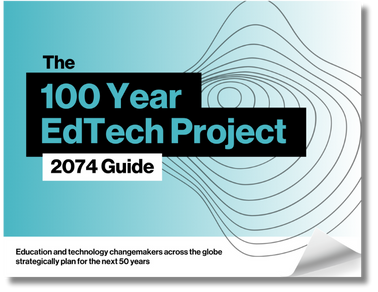
See last year’s 2074 guide and other community artifacts at 100yearedtechproject.org
Join us at the 2026 Design Summit, hosted by The University of Texas at San Antonio from February 10-12.
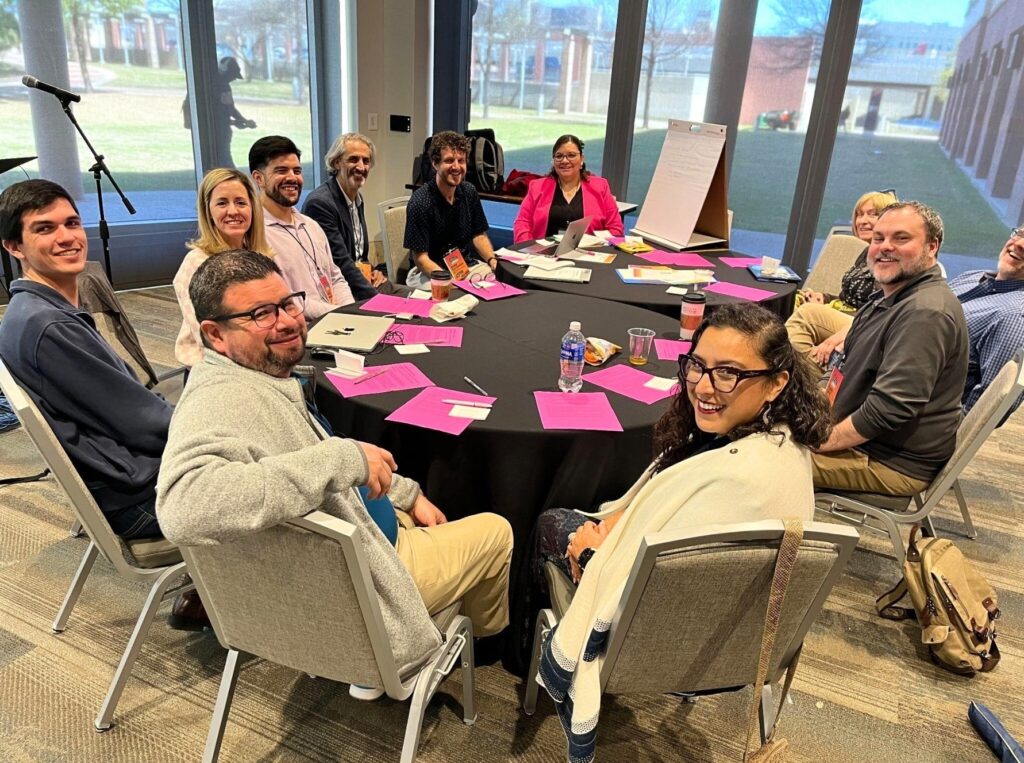

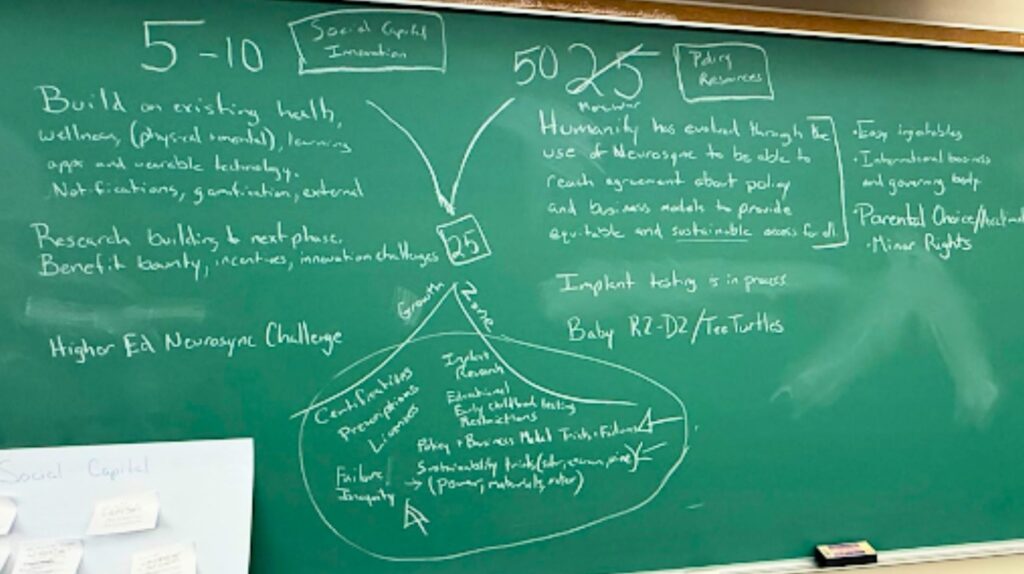
Here’s how you can begin to apply this work in practice:
- Use the 10–25–50 structure to reframe your next planning or strategy session. Invite your team to map near-, mid-, and long-term goals, and consider who is centered in each phase.
- Create a future timeline that pairs your organization’s direction with external drivers like technology, climate, policy, and culture.
- Invite diverse stakeholders — students, staff, community partners — to co-design those futures with you.
- Use storytelling as a strategic tool. Write speculative stories about your institution or initiative 50 years from now, then work backward to identify the steps needed to make them real.
- Run a scenario sprint using one of the futures from this guide. Break the work into 10, 25, and 50-year phases and explore how solutions might unfold.
- Turn the Common Threads into design principles. Use them to evaluate existing work, surface tensions, or guide a new initiative.
- Pilot one of the proposed solutions. Whether you’re testing curiosity-centered assessments, emotional wellbeing infrastructure, or modular credentials, prototype it, document the process, and share what you learn.
- Reconnect to your values. Ask: Are we designing systems that reflect care, trust, learner agency, and long-term stewardship?
The next 50 years aren’t just something we inherit. They are something we write together, with imagination and intention.
Interested in sponsoring the 100 Year EdTech Project? Contact samantha@sabconsulting.org
Acknowledgements
It has taken a collective effort from individuals across the country to bring this publication into existence. We are grateful for the creativity and ideas of every individual who personally contributed to the 100 Year EdTech Project. Our authors, participants, sponsors, facilitators and panelists are listed below.
Core Planning Committee:
Lev Gonick, Arizona State University
Allison Hall, Arizona State University
Kyle Bowen, Arizona State University
Samantha Becker, SAB Creative & Consulting
Angela Gunder, Opened Culture
Melissa Vito, The University of Texas at San Antonio
Stephanie King, SAB Creative & Consulting
Marcela Ramirez, The University of Texas at San Antonio
Amy Buechler-Steubing, The University of Texas at San Antonio
Tammy Wyatt, The University of Texas at San Antonio
Shailee Shah, Arizona State University
Bea Rodriguez-Fransen, ASU Next Lab
Jake Erney, The University of Texas at San Antonio
Anita Garza, The University of Texas at San Antonio
Stephanie Sacrista, The University of Texas at San Antonio
Melissa Mahan, The University of Texas at San Antonio
Working Group Facilitators:
Brian Arnold, National University
Kiara Williams, The Archive
Bea Rodriguez-Fransen, ASU Next Lab
Tammy Wyatt, UTSA
Christa Krohn, TIES, Teaching Institute for Excellence in STEM
Mike Yates, The Reinvention Lab, Teach for America
Andrew Gorvetzian, The University of New Mexico
Marcela Ramirez, UTSA
Steven Johnson, EDSENSE LLC
Amy Beuchler-Steubing, UTSA
Allison Hall, Arizona State University
Chris Morett, Co|Here Campus and Workplace
Eric Silva, UTSA
Jocelyn Widmer, Los Alamos National Laboratory
Jessica Zeitler, University of Arizona
Fiore Bran-Gorvetzian, The University of New Mexico
Georgia Davis, University of Arizona
Jenny Frank, TIES, Teaching Institute for Excellence in STEM
Elyse Ramirez, UTSA
Linda Calvin, Reboot Representation
Isabella Johnston, Employers 4 Change
Rob Gibson, WSU Tech
Melissa Mahan, UTSA
Authors:
Samantha Becker, SAB Creative & Consulting
Lev Gonick, Arizona State University
Angela Gunder, OpenEd Culture
Allison Hall, Arizona State University
Jennifer Martin, SAB Creative & Consulting
Melissa Vito, The University of Texas at San Antonio
Brian Arnold, National University
Kiara Williams, The Archive
Bea Rodriguez-Fransen, ASU Next Lab
Tammy Wyatt, UTSA
Christa Krohn, TIES, Teaching Institute for Excellence in STEM
Mike Yates, The Reinvention Lab, Teach for America
Andrew Gorvetzian, The University of New Mexico
Marcela Ramirez, UTSA
Steven Johnson, EDSENSE LLC
Amy Beuchler-Steubing, UTSA
Allison Hall, Arizona State University
Chris Morett, Co|Here Campus and Workplace
Eric Silva, UTSA
Jocelyn Widmer, Los Alamos National Laboratory
Jessica Zeitler, University of Arizona
Fiore Bran-Gorvetzian, The University of New Mexico
Georgia Davis, University of Arizona
Jenny Frank, TIES, Teaching Institute for Excellence in STEM
Elyse Ramirez, UTSA
Linda Calvin, Reboot Representation
Isabella Johnston, Employers 4 Change
Rob Gibson, WSU Tech
Melissa Mahan, UTSA
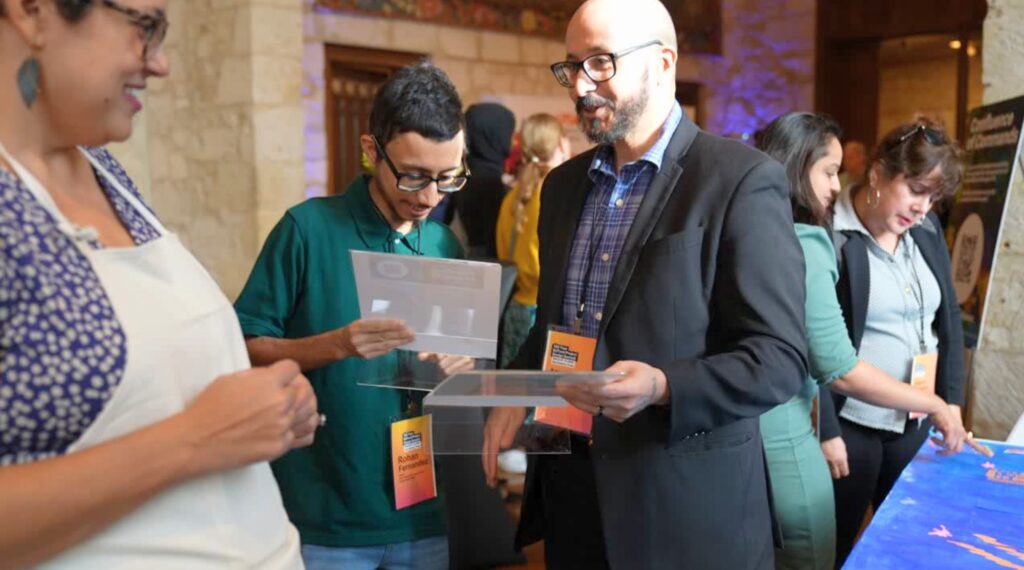
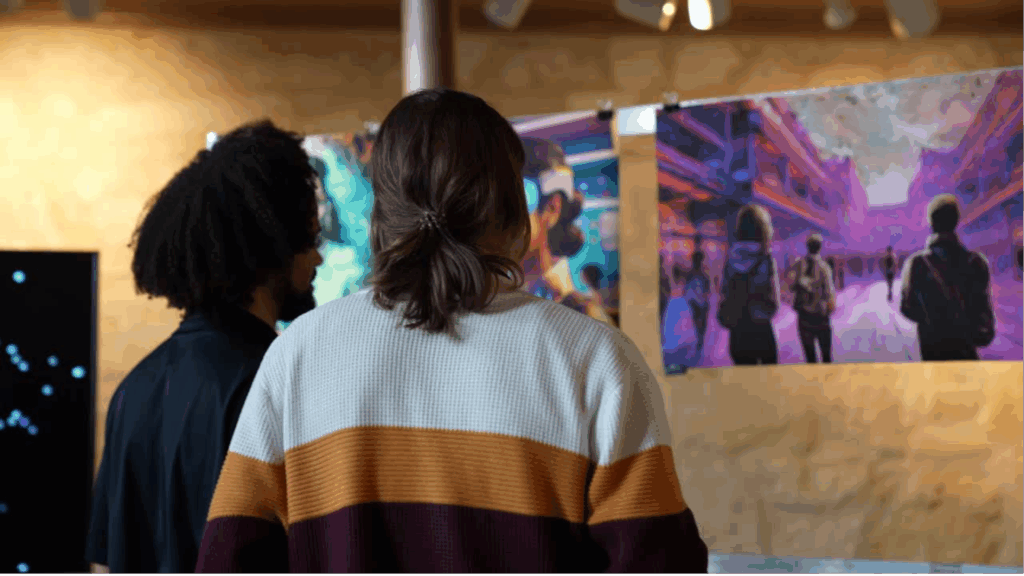
Design Summit Participants
Isabella Aguirre
Maria Andersen
Claudia Arcolin
Brian Arnold
Angela Baldasare
William Ballard
Nori Barajas
Dustin Barrows
Brendan Baruth
Samantha Becker
Tracey Birdwell
Edwin Blanton
Kyle Bowen
Fiore S. Bran Aragon
Ariana Bridges
Beth Brunk
Naphtali Bryant
Amy Buechler-Steubing
Josh Buetow
Rick Burnette
Gerard Bustos
Patricia Butler
Basak Buyukcelen
Linda Calvin
Renee Canete
Orlando Cantu
Enrique Carbonell Enriquez
Jacqueline Cardenas
David Castillo
Sonia Chaidez
Brett Christie
Madison Cowels
Maria Crabtree
Chris Cummings
Robert Cummings
Julie Curtis
Cheree Daniels
Nova Davidson
Annie Davis
Georgia Davis
Phillip Davis
Van Davis
Suzana Diaz-Rosencrans
Kyle Dickson
Sebastian Distefano
Shannon Dowling
Robert Duvall
Leigh Eldred
Jake Erney
Rodolfo Esparza
Miguel Fernandez
Rohan Fernandez
Izzy Fitzgerald
Cristi Ford
Anita Garza
Rob Gibson
Lev Gonick
Gabriella Gonzales
Paul Gonzalez
Andy Gorvetzian
Tom Green
Chris Greenough
Angela Gunder
Matt Gurney
Amanda Gutman
Jabib Haghiran
Allison Hall
Darcy Hardy
Monica Hernandez
Archie Holmes
Amy Huson
Leena Idris
Clarissa Idrogo
John Janezic
Sebastian Jimenez
Steven Johnson
Isabella Johnston
Lila Jordan
Mike Kentz
Donna Kidwell
Thanush Koshekay
Christa Krohn
Austin Laird
Joe Lambert
Bao Le
Will Louis
Melissa Mahan
Naz Maknojia
Dannie Martinez
Jenna Matthews
Susan McCahan
RaLynn McGuire
John McKnight
Bridget McNamara
Michael Menzies
Michael Meth
Briana Miller
Shawn Miller
Sarah Montalvo
Martha Moreno
Chris Morett
Javier Motta-Mena
Dan Munnerley
Javier No Sanchez
Jochebed Nyong’a
Dillion O’Con
Carrie O’Donnell
Christopher Ortega
Myriam Ortega
Silvina Padilla
Sunay Palsole
Daisy Paredes
Kathlene Pelletier
Renee Pilbeam
Ruben Puentedura
Riccardo Purita
Amin Qazi
Randy Quinn
Rahim Rajan
Marcela Ramirez
Elyse Ramirez
Natasha Ranjan
Megan Raymond
Mikaela Razo
Brenda Rivera
Jenay Robert
Bea Rodriguez-Fransen
Weston Rose
Stephanie Sacriste
Zacaria Sadiqui
Aidan Schatzki-Lumpkin
Noah Schwencke
Shailee Shah
Christina Shutt
Eric Silva
Wendy Simmerman
Michelle Singh
Amber Smallwood
Jennifer Sparrow
Christen Stanley
Michael Stewart
Todd Taylor
Megan Tesene
Michael Thompson
Joe Tobares
Monica Tobares
Michael Tringe
Mike Truong
Sydney Tweedley
April Valdez
Gabriela Valdez
Michael Valdez
Mario Vela
Karen Vignare
Melissa Vito
Jocelyn Widmer
Claudia Wiedeman
Bonnie Wilde
Brittany Williams
Kiara Williams
Megan Workmon Larsen
Tammy Wyatt
Mike Yates
Stacy Ybarra
Keith Young
Margaret Young
Jessica Zeitler
Bianca Zietal
Emma Zone
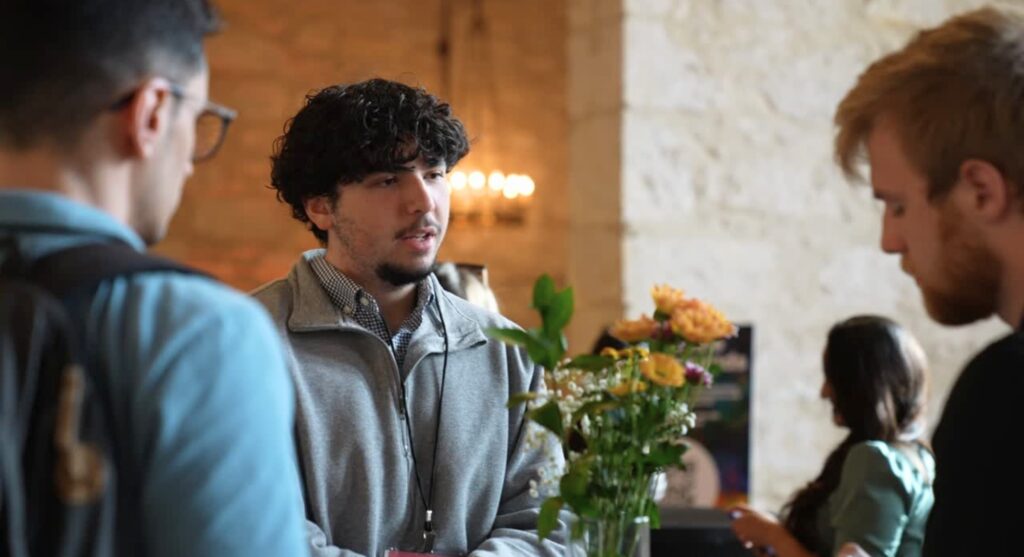
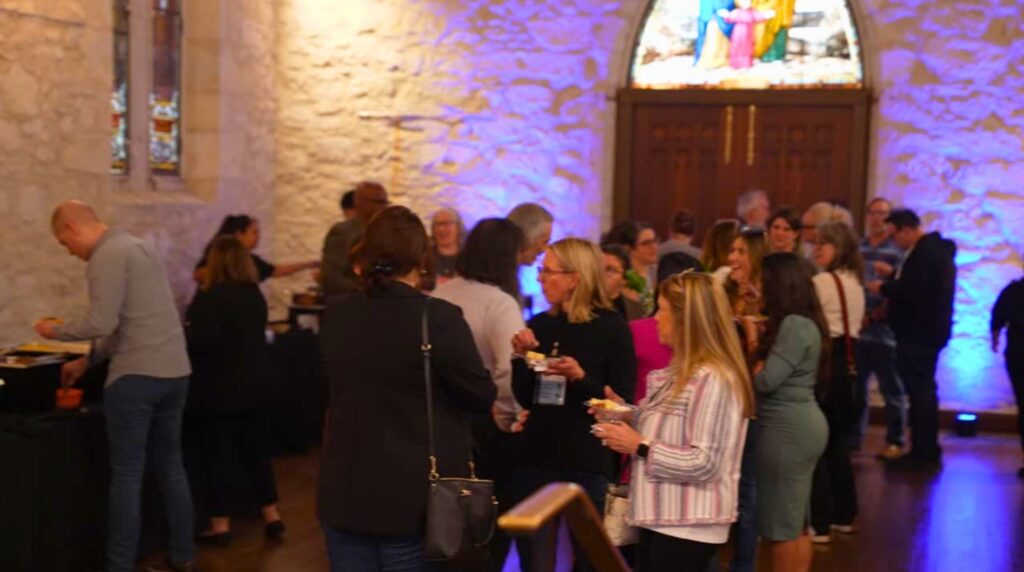
The 100 Year EdTech Project 2075 Guide is published under a Creative Commons Attribution-Noncommerical 4.0 license to encourage free and open use, adaptation, and remixing.
Official citation for attribution:
The 100 Year EdTech Project 2074 Guide: Adams Becker, S.; Gonick, L.; Davis, G.; Hall, A.; Janezic, J.; Kovaleski, K.; and Lambert, J. 2024. CC BY-NC 4.0
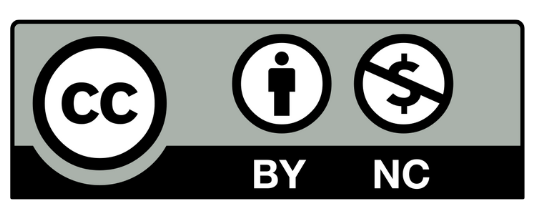
“We look forward to the futures you will design — futures built through collaboration, grounded in purpose, and sustained by communities who dare to create together.”
— Samantha Becker &
Angela Gunder
100yearedtechproject.org



